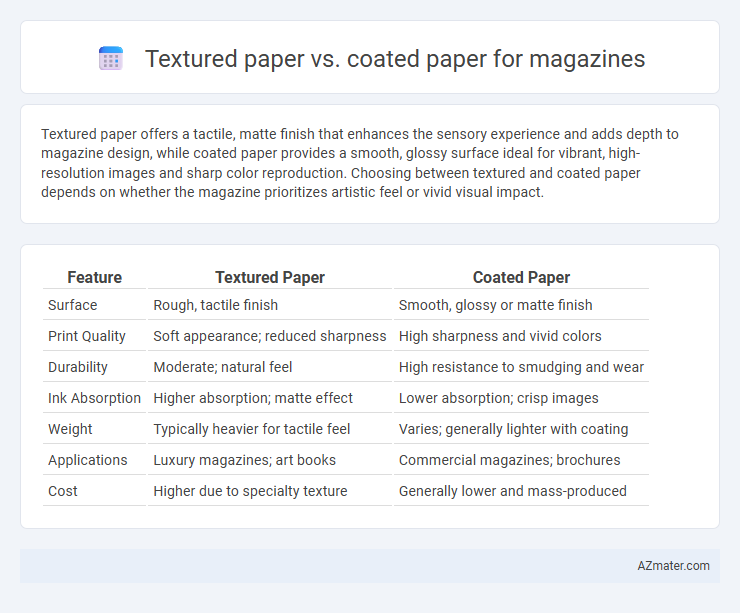Textured paper offers a tactile, matte finish that enhances the sensory experience and adds depth to magazine design, while coated paper provides a smooth, glossy surface ideal for vibrant, high-resolution images and sharp color reproduction. Choosing between textured and coated paper depends on whether the magazine prioritizes artistic feel or vivid visual impact.
Table of Comparison
| Feature | Textured Paper | Coated Paper |
|---|---|---|
| Surface | Rough, tactile finish | Smooth, glossy or matte finish |
| Print Quality | Soft appearance; reduced sharpness | High sharpness and vivid colors |
| Durability | Moderate; natural feel | High resistance to smudging and wear |
| Ink Absorption | Higher absorption; matte effect | Lower absorption; crisp images |
| Weight | Typically heavier for tactile feel | Varies; generally lighter with coating |
| Applications | Luxury magazines; art books | Commercial magazines; brochures |
| Cost | Higher due to specialty texture | Generally lower and mass-produced |
Introduction to Magazine Paper Types
Textured paper offers a tactile, embossed surface that enhances visual depth and adds a premium feel to magazine covers and inserts, making it ideal for high-end publications. Coated paper features a smooth, glossy or matte finish that improves image sharpness and color vibrancy, ensuring vivid photo reproduction and crisp typography throughout magazine pages. Selecting between textured and coated paper depends on the magazine's aesthetic goals, with textured paper emphasizing sensory appeal and coated paper prioritizing visual clarity and print quality.
What is Textured Paper?
Textured paper for magazines features a tactile surface with raised patterns or embossed designs that enhance sensory engagement and visual appeal. This type of paper provides a unique feel and sophisticated look, making it ideal for luxury publications or artistic content. Unlike coated paper, which has a smooth, glossy or matte finish for vibrant image reproduction, textured paper emphasizes depth and materiality, adding dimension to printed pages.
What is Coated Paper?
Coated paper is a type of paper that has a surface coated with a mixture of materials such as clay and latex to create a smooth finish, enhancing ink adhesion and producing sharper, more vibrant images in magazines. It is available in various finishes like gloss, matte, or satin, which influence the magazine's overall look and feel, often providing a more polished and professional appearance. Compared to textured paper, coated paper reduces ink absorption, allowing for higher-resolution printing and better color reproduction, making it the preferred choice for high-quality photo and image-heavy magazine layouts.
Visual Appeal: Textured vs Coated Paper
Textured paper offers a tactile, sophisticated look that enhances the visual appeal of magazines with a natural, matte finish, creating a unique sensory experience for readers. Coated paper delivers vibrant, sharp images and high contrast due to its glossy or satin surface, making colors appear more intense and details more defined. The choice between textured and coated paper directly influences the magazine's aesthetic impact, balancing tactile sophistication against vivid visual clarity.
Print Quality Differences
Textured paper enhances magazine print quality by providing a tactile surface that diffuses light, resulting in softer images with reduced glare and a premium feel. Coated paper delivers sharper, more vibrant print results due to its smooth, non-absorbent finish, which intensifies color saturation and detail clarity. Choosing between textured and coated paper impacts the overall visual impact and reader experience, with textured paper favoring artistic, matte aesthetics and coated paper excelling in vivid, high-definition visuals.
Tactile Experience for Readers
Textured paper enhances the tactile experience in magazines by providing a tactile grain that adds depth and a luxurious feel to each page, engaging readers through touch as well as sight. Coated paper offers a smooth, glossy finish that intensifies color vibrancy and sharpness, creating a visually striking but less tactilely dynamic surface. Choosing textured paper elevates the sensory interaction, making the reading experience more memorable and immersive for magazine audiences.
Suitability for Magazine Content
Textured paper enhances magazines featuring artistic photography, fashion spreads, or tactile elements by adding depth and a unique sensory experience. Coated paper offers a smooth finish that intensifies color vibrancy and sharpness, making it ideal for magazines with high-resolution images and detailed graphics. Choosing between textured and coated paper depends on the magazine's emphasis on visual impact versus tactile appeal.
Cost Comparison
Textured paper generally costs more than coated paper due to higher manufacturing expenses and limited availability, impacting overall magazine production budgets. Coated paper offers a more economical choice with smoother finishes, enabling bulk printing at lower costs while maintaining image quality. Publishers often select coated paper to optimize cost efficiency without compromising visual appeal in magazine printing.
Environmental Impact of Each Paper Type
Textured paper for magazines often uses less chemical processing and fewer coatings, resulting in a lower environmental impact due to reduced energy consumption and fewer pollutants released during production. Coated paper contains a mineral or polymer layer that enhances print quality but requires intensive manufacturing processes, increasing water usage and chemical waste, which can harm ecosystems if not managed properly. Choosing recycled or FSC-certified textured paper can further minimize environmental footprint compared to non-recycled coated paper options.
Choosing the Right Paper for Your Magazine
Textured paper offers a tactile, premium feel that enhances visual depth and reader engagement, ideal for luxury or art-focused magazines. Coated paper provides a smooth surface with vibrant color reproduction and sharp image quality, making it suitable for high-volume, image-heavy publications. Selecting the right paper depends on your magazine's aesthetic goals, target audience, and budget constraints to ensure optimal print performance and reader experience.

Infographic: Textured paper vs Coated paper for Magazine
 azmater.com
azmater.com